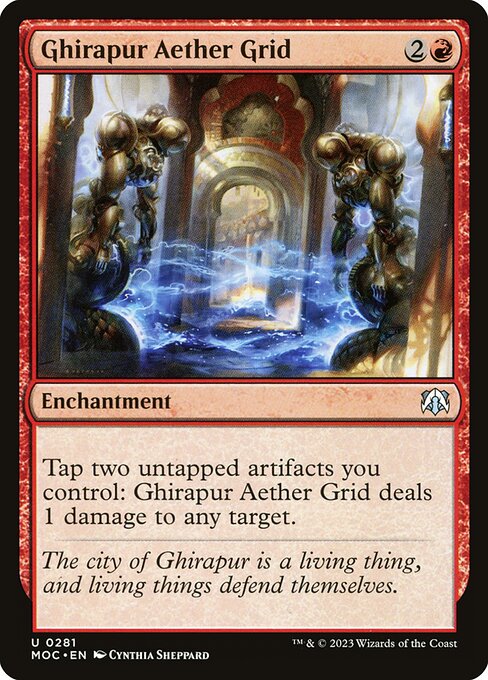
Image courtesy of Scryfall.com
Ghirapur Aether Grid and the Parody-Fueled Identity of MTG Fans
Parody isn’t just a joke thread on a card-collecting forum; it’s a living fingerprint on MTG fandom. Fans remix mechanics, flavor text, and card names into shared inside jokes that travel across gatherings, streams, and print runs. When you slot Ghirapur Aether Grid into a conversation about fan identity, you’re looking at a card that sits at a clever crossroads: red’s appetite for immediacy and disruption, and the community’s appetite for playful self-reflection. This uncommon enchantment from the March of the Machine Commander set isn’t just a tool to ping faces; it’s a narrative spark that invites players to think about how we curate our decks, our humor, and our online persona at the same time 🧙♂️🔥.
The card itself is lean and direct: a {2}{R} mana cost, a three-mana investment that leans into red’s classic appetite for action. As an Enchantment, Ghirapur Aether Grid asks you to commit two untapped artifacts you control to deal 1 damage to any target. It’s not a one-shot nuke, but a persistent, spicy poke that rewards setup and tempo in a color that prizes urgency. The rarity is Uncommon in March of the Machine Commander, a designation that feels fitting for a card that wants you to lean into a wider artifact sytem rather than a single explosive play. In the long arc of MTG design, that mirrors how fans often deploy humor as a social resource: small, repeatable, and enough to swing a conversation or a game at just the right moment 🎲.
Flavor text notes that “The city of Ghirapur is a living thing, and living things defend themselves.” That line nods to a broader MTG storytelling tradition—the idea that places within the Multiverse aren’t inert stages but dynamic actors. In fandom discussions, that dynamism translates into how players defend their own preferred playstyles and aesthetic. The Aether Grid’s grid motif—an interface between artifacts and powered energy—becomes a metaphor for how fans map their own identities: interconnected, resourceful, and sometimes a little electric in the best sense. It’s easy to see why parody flourishes here: the card’s structure invites fans to riff on technology, urban mythos, and the social rituals of modern cube games and Commander nights 🧙♂️⚡.
“Two artifacts, one spark, a city that cares enough to ping back.”
Mechanically, Aether Grid embodies red’s love of finite, repeatable interaction with a splash of pragmatism. You’re not detonating a dragon with a single spell; you’re managing a dance of artifacts, timing, and target selection. The requirement to tap two untapped artifacts you control creates a natural synergy with artifact-heavy decks—think mana rocks, lunchbox cards, and toolbox permanents that keep your options open. That design invites fans to imagine playful two-step combos, like using cheap artifacts to pace damage while saving longer-game plans. In a sense, the card mirrors the way fans build their online personas: small, deliberate, and capable of creating a surprising ripple when positioned correctly in the broader conversation 🔥.
From a design perspective, Ghirapur Aether Grid sits neatly at the intersection of art, playability, and fan culture. Cynthia Sheppard’s artwork—rich with the idea of a city that pulses with energy—echoes the theme of a living urban organism defending itself. The card’s placement in a Commander set underscores its suitability for social playgroups where humor and memory are as valuable as any spell. The collector’s eye will notice the set’s emphasis on a lively, interactive approach to combat and control, a vibe that resonates with fans who collect not just for cash value but for the stories those cards tell as part of their personal MTG saga 🧩💎.
Parody, in this context, becomes a social currency. Fans riff on the idea of a “grid” powering a city, creatively turning it into memes about community resilience, DIY modding, and even the online drama of deckbuilding. The card’s simple, repeatable effect makes it a favorite drumbeat for joke timing in streams or coffee-table conversations—two untapped artifacts, one nudge of damage, and a room that recognizes the wink. The humor lands because MTG fans care about both the mechanics and the lore, about the way a city of living stone and circuitry can mirror a player’s own narrative arc. It’s a reminder that parody isn’t a peripheral hobby; it’s a cornerstone of how fans express craft, craftiness, and camaraderie 🎨🧙♂️.
Practical play advice for those who want to harness this card’s energy: lean into artifact ramp and artifact synergy. Early turns can focus on establishing a small battery of rocks, a couple of artifacts that generate mana or card advantage, and then drop Aether Grid to pressure opponents and pilots alike. In Commander, where threats multiply and politics reign, a steady ping from the Grid can be enough to tilt a stalemate in your favor. The card’s energy motif is also a perfect metaphor for a modern playgroup: you’re building a network, not a solo show, and the Grid rewards players who cultivate a culture of consistent, thoughtful interaction 🧙♂️⚔️.
For collectors and players who love a little cross-promotion magic, a handy companion in your day-to-day is a sturdy, portable way to carry pockets of your MTG life. If you’re a fan who values both function and flair, consider bringing a practical, card-friendly accessory along for the journey. The product linked below—an accessible phone case with a card holder—treats your cards like the valuable artifacts they are, while keeping your everyday carry clean, organized, and ready for impromptu drafts or casual nights at the local store. It’s a subtle nod to the same energy grid that powers Ghirapur on game night, translated into a tangible, real-world sliver of MTG culture 🔥🧿.
Phone Case with Card Holder (Polycarbonate Matte/Glossy)
More from our network
- https://crypto-acolytes.xyz/blog/post/whats-next-for-multichain-liquidity-hubs/
- https://crypto-acolytes.xyz/blog/post/tracing-floki-inu-origins-and-growth/
- https://transparent-paper.shop/blog/post/subtle-linen-paper-effects-for-modern-digital-design/
- https://blog.zero-static.xyz/blog/post/nostalgia-waves-reshape-sure-strike-prices-in-commander/
- https://transparent-paper.shop/blog/post/silent-distinctions-between-singles-and-multiples-in-sagittarius-blue-white-giant/